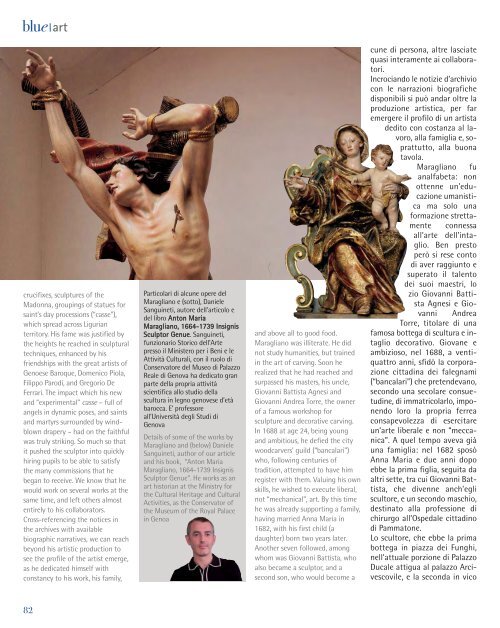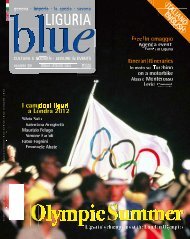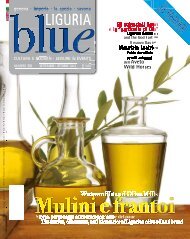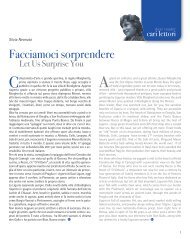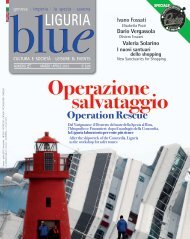BLUE NEW 31_215x270 - Blue Liguria - Sagep
BLUE NEW 31_215x270 - Blue Liguria - Sagep
BLUE NEW 31_215x270 - Blue Liguria - Sagep
Create successful ePaper yourself
Turn your PDF publications into a flip-book with our unique Google optimized e-Paper software.
lue<br />
art<br />
crucifixes, sculptures of the<br />
Madonna, groupings of statues for<br />
saint’s day processions (“casse”),<br />
which spread across <strong>Liguria</strong>n<br />
territory. His fame was justified by<br />
the heights he reached in sculptural<br />
techniques, enhanced by his<br />
friendships with the great artists of<br />
Genoese Baroque, Domenico Piola,<br />
Filippo Parodi, and Gregorio De<br />
Ferrari. The impact which his new<br />
and “experimental” casse – full of<br />
angels in dynamic poses, and saints<br />
and martyrs surrounded by windblown<br />
drapery – had on the faithful<br />
was truly striking. So much so that<br />
it pushed the sculptor into quickly<br />
hiring pupils to be able to satisfy<br />
the many commissions that he<br />
began to receive. We know that he<br />
would work on several works at the<br />
same time, and left others almost<br />
entirely to his collaborators.<br />
Cross-referencing the notices in<br />
the archives with available<br />
biographic narratives, we can reach<br />
beyond his artistic production to<br />
see the profile of the artist emerge,<br />
as he dedicated himself with<br />
constancy to his work, his family,<br />
Particolari di alcune opere del<br />
Maragliano e (sotto), Daniele<br />
Sanguineti, autore dell'articolo e<br />
del libro Anton Maria<br />
Maragliano, 1664-1739 Insignis<br />
Sculptor Genue. Sanguineti,<br />
funzionario Storico dell’Arte<br />
presso il Ministero per i Beni e le<br />
Attività Culturali, con il ruolo di<br />
Conservatore del Museo di Palazzo<br />
Reale di Genova ha dedicato gran<br />
parte della propria attività<br />
scientifica allo studio della<br />
scultura in legno genovese d’età<br />
barocca. E’ professore<br />
all’Università degli Studi di<br />
Genova<br />
Details of some of the works by<br />
Maragliano and (below) Daniele<br />
Sanguineti, author of our article<br />
and his book, “Anton Maria<br />
Maragliano, 1664-1739 Insignis<br />
Sculptor Genue”. He works as an<br />
art historian at the Ministry for<br />
the Cultural Heritage and Cultural<br />
Activities, as the Conservator of<br />
the Museum of the Royal Palace<br />
in Genoa<br />
and above all to good food.<br />
Maragliano was illiterate. He did<br />
not study humanities, but trained<br />
in the art of carving. Soon he<br />
realized that he had reached and<br />
surpassed his masters, his uncle,<br />
Giovanni Battista Agnesi and<br />
Giovanni Andrea Torre, the owner<br />
of a famous workshop for<br />
sculpture and decorative carving.<br />
In 1688 at age 24, being young<br />
and ambitious, he defied the city<br />
woodcarvers’ guild (“bancalari”)<br />
who, following centuries of<br />
tradition, attempted to have him<br />
register with them. Valuing his own<br />
skills, he wished to execute liberal,<br />
not “mechanical”, art. By this time<br />
he was already supporting a family,<br />
having married Anna Maria in<br />
1682, with his first child (a<br />
daughter) born two years later.<br />
Another seven followed, among<br />
whom was Giovanni Battista, who<br />
also became a sculptor, and a<br />
second son, who would become a<br />
cune di persona, altre lasciate<br />
quasi interamente ai collaboratori.<br />
Incrociando le notizie d’archivio<br />
con le narrazioni biografiche<br />
disponibili si può andar oltre la<br />
produzione artistica, per far<br />
emergere il profilo di un artista<br />
dedito con costanza al lavoro,<br />
alla famiglia e, soprattutto,<br />
alla buona<br />
tavola.<br />
Maragliano fu<br />
analfabeta: non<br />
ottenne un’educazione<br />
umanistica<br />
ma solo una<br />
formazione strettamente<br />
connessa<br />
all’arte dell’intaglio.<br />
Ben presto<br />
però si rese conto<br />
di aver raggiunto e<br />
superato il talento<br />
dei suoi maestri, lo<br />
zio Giovanni Battista<br />
Agnesi e Giovanni<br />
Andrea<br />
Torre, titolare di una<br />
famosa bottega di scultura e intaglio<br />
decorativo. Giovane e<br />
ambizioso, nel 1688, a ventiquattro<br />
anni, sfidò la corporazione<br />
cittadina dei falegnami<br />
(“bancalari”) che pretendevano,<br />
secondo una secolare consuetudine,<br />
di immatricolarlo, imponendo<br />
loro la propria ferrea<br />
consapevolezza di esercitare<br />
un’arte liberale e non “meccanica”.<br />
A quel tempo aveva già<br />
una famiglia: nel 1682 sposò<br />
Anna Maria e due anni dopo<br />
ebbe la prima figlia, seguita da<br />
altri sette, tra cui Giovanni Battista,<br />
che divenne anch’egli<br />
scultore, e un secondo maschio,<br />
destinato alla professione di<br />
chirurgo all’Ospedale cittadino<br />
di Pammatone.<br />
Lo scultore, che ebbe la prima<br />
bottega in piazza dei Funghi,<br />
nell’attuale porzione di Palazzo<br />
Ducale attigua al palazzo Arcivescovile,<br />
e la seconda in vico<br />
82


